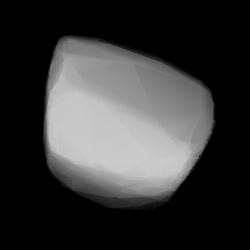 3D model based on lightcurve data 3D model based on lightcurve data | |
| Discovery | |
|---|---|
| Discovered by | N. R. Pogson |
| Discovery date | 6 February 1885 |
| Designations | |
| MPC designation | (245) Vera |
| Pronunciation | /ˈvɪərə/ |
| Alternative designations | A885 CA, 1919 HB |
| Minor planet category | Main belt |
| Orbital characteristics | |
| Epoch 31 July 2016 (JD 2457600.5) | |
| Uncertainty parameter 0 | |
| Observation arc | 131.06 yr (47,869 d) |
| Aphelion | 3.70600 AU (554.410 Gm) |
| Perihelion | 2.50409 AU (374.607 Gm) |
| Semi-major axis | 3.10504 AU (464.507 Gm) |
| Eccentricity | 0.19354 |
| Orbital period (sidereal) | 5.47 yr (1,998.5 d) |
| Average orbital speed | 16.93 km/s |
| Mean anomaly | 120.926° |
| Mean motion | 0° 10 48.493 / day |
| Inclination | 5.15859° |
| Longitude of ascending node | 61.2968° |
| Argument of perihelion | 329.674° |
| Physical characteristics | |
| Dimensions | 79.50±3.2 km |
| Synodic rotation period | 14.38 h (0.599 d) |
| Geometric albedo | 0.2082±0.018 |
| Temperature | unknown |
| Spectral type | S |
| Absolute magnitude (H) | 7.82 |
245 Vera is a large Main belt asteroid. It was discovered by N. R. Pogson on February 6, 1885, in Madras, and was named at the suggestion of his wife. The asteroid is orbiting the Sun at a distance of 3.11 AU with a period of 5.47 years and an eccentricity (ovalness) of 0.19. The orbital plane is tilted at an angle of 5.16° to the plane of the ecliptic. In 1890, Daniel Kirkwood noted that this asteroid shares similar orbital elements with 86 Semele and 106 Dione.
Photometric measurements of this asteroid made during 1980–1981 were used to produce a light curve that demonstrated a rotation period of 14.38±0.03 h with a brightness variation of 0.26±0.01 in magnitude. It is classified as a stony S-type asteroid in the Tholen system. The asteroid has an estimated diameter of 75.95±2.63 km based on near infrared observations.
References
- ^ "245 Vera". JPL Small-Body Database. NASA/Jet Propulsion Laboratory. Retrieved 12 May 2016.
- ^ Xu, Shui; et al. (May 1995), "Small Main-belt Asteroid Spectroscopic Survey: initial results", Icarus, 115 (1): 1–35, Bibcode:1995Icar..115....1X, doi:10.1006/icar.1995.1075.
- Discovery Circumstances: Numbered Minor Planets (1)-(5000), IAU: Minor Planet Center, archived from the original on 2 July 2007, retrieved 12 September 2021.
- Schmadel, Lutz D. (2013), Dictionary of Minor Planet Names, Springer Berlin Heidelberg, ISBN 9783662028049.
- Kirkwood, Daniel (1890), "On the similarity of certain orbits in the zone of asteroids", Publications of the Astronomical Society of the Pacific, 2 (7): 95–97, doi:10.1086/120087, S2CID 120889567.
- Debehogne, H.; et al. (November 1982), "Physical studies of asteroids. VIII - Photoelectric photometry of the asteroids 42, 48, 93, 105, 145 and 245", Astronomy and Astrophysics Supplement Series, 50: 277–281, Bibcode:1982A&AS...50..277D.
- Masiero, Joseph R.; et al. (August 2014), "Main-belt Asteroids with WISE/NEOWISE: Near-infrared Albedos", The Astrophysical Journal, 791 (2): 11, arXiv:1406.6645, Bibcode:2014ApJ...791..121M, doi:10.1088/0004-637X/791/2/121, S2CID 119293330, 121.
Further reading
- The Asteroid Orbital Elements Database
- Asteroid Lightcurve Data File
- Scaling the magnitude: the fall and rise of N. R. Pogson pg. 243
External links
- 245 Vera at AstDyS-2, Asteroids—Dynamic Site
- 245 Vera at the JPL Small-Body Database

| Minor planets navigator | |
|---|---|
| Small Solar System bodies | |||||||
|---|---|---|---|---|---|---|---|
| Minor planets |
| ||||||
| Comets | |||||||
| Other | |||||||
This article about an S-type asteroid native to the asteroid belt is a stub. You can help Misplaced Pages by expanding it. |